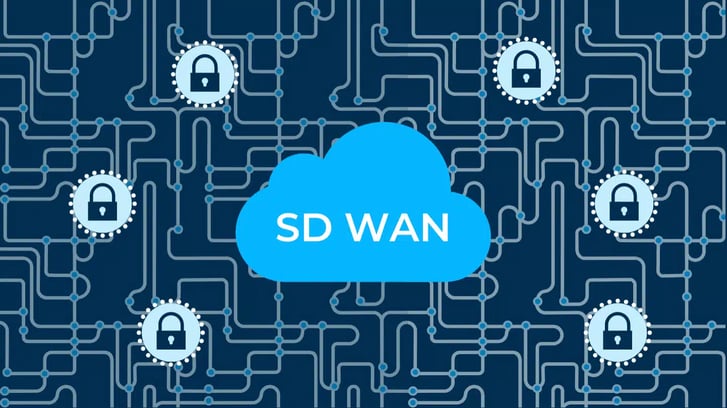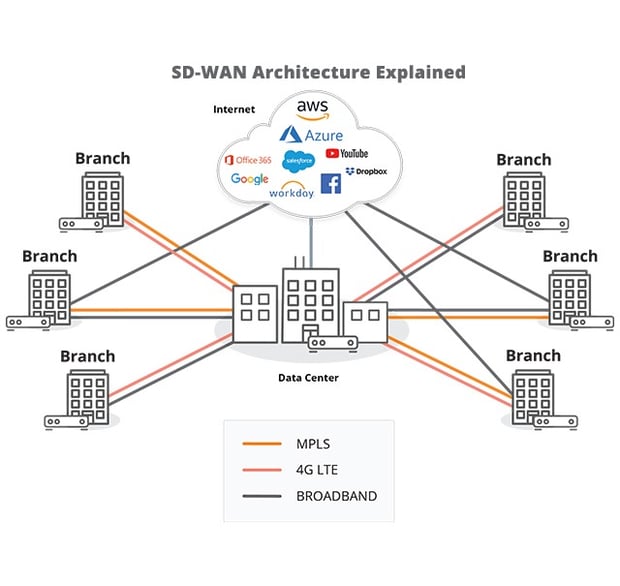In the rapidly evolving landscape of the digital world, where connectivity and data exchange are fundamental to modern business operations, SD-WAN has emerged as a transformative force.
As organizations increasingly rely on cloud applications and remote work, the demand for a more flexible and efficient approach to managing wide area networks has never been greater.
SD-WAN represents a paradigm shift in network technology. It provides businesses with a dynamic and intelligent solution to address the complexities of modern connectivity, ensuring optimal performance and responsiveness in an ever-changing digital environment. This article will highlight what SD-WAN is, how it functions, and why it can benefit organizations looking forward.
What is SD-WAN?
SD-WAN, or Software-Defined Wide Area Network, is a technology that has revolutionized the way organizations manage their networks and connect their branch offices or remote locations.
SD-WAN allows organizations to connect and manage their wide area networks (WANs) in a more efficient and flexible way. Unlike traditional WAN architectures that rely on expensive and complex hardware, SD-WAN utilizes software and virtualization to simplify network management and improve performance.
With SD-WAN, organizations can centralize control over their network infrastructure and easily configure and manage it through a centralized management interface. This enables them to optimize network traffic, prioritize critical applications, and dynamically allocate bandwidth based on their specific needs.
In addition to improved network management, SD-WAN also offers enhanced security features. It can encrypt data traffic, segment network traffic to prevent unauthorized access, and provide real-time visibility into network activity for better threat detection and response.

How Does SD-WAN Work?
SD-WAN works by abstracting the underlying network infrastructure and separating the control plane from the data plane. This allows for centralized control and management of the network, regardless of the physical devices and connections being used.
In a typical SD-WAN architecture, there are two main components:
-
SD-WAN controller
-
SD-WAN edge devices
The controller acts as the centralized brain of the network, overseeing the entire network and making intelligent decisions about traffic routing and optimization.
The edge devices, which can be physical or virtual appliances, are deployed at each branch location and connect to the controller. They establish secure tunnels over various connections, such as MPLS, broadband, or LTE, and forward traffic based on the policies set by the controller.
In simple terms, think of SD-WAN as a smart traffic cop for your internet connections. It looks at all the different paths data can take to get from one place to another and chooses the best route based on factors like speed, cost, and reliability. This helps businesses improve their network performance, reduce costs, and make their network more flexible and responsive to their needs.
Through the use of intelligent algorithms and real-time monitoring, SD-WAN can dynamically route traffic across the most optimal paths, based on factors like latency, packet loss, and available bandwidth. This ensures that critical applications receive the necessary resources and guarantees a consistent user experience.
Here is the SD-WAN architecture explained:

Key Features of SD WAN
SD-WAN brings a multitude of essential features that set it apart from conventional WAN solutions:
- Centralized management: SD-WAN provides a single interface to monitor and configure the entire network, simplifying management tasks and reducing operational overhead.
- Dynamic path selection: SD-WAN can intelligently select the best path for traffic based on real-time conditions, ensuring optimal performance and reliability.
- Quality of Service (QoS): SD-WAN enables prioritization of critical applications and traffic types, ensuring that they receive the necessary bandwidth and performance.
- Security: SD-WAN incorporates security features like encryption, segmentation, and threat detection to protect network traffic and data.
- Scalability: SD-WAN can easily scale to accommodate growing network demands, allowing organizations to add new branches or increase bandwidth without significant hardware investments.
The Benefits of SD-WAN
SD-WAN offers several benefits for organizations:
- Cost savings: By leveraging inexpensive broadband or LTE connections alongside traditional MPLS, organizations can significantly reduce their WAN costs.
- Improved performance: SD-WAN can optimize traffic routing and prioritize critical applications, resulting in faster application performance and reduced latency.
- Enhanced security: With built-in security features, SD-WAN improves data protection and network security, reducing the risk of unauthorized access and data breaches.
- Simplified management: SD-WAN provides a centralized management interface, making it easier to configure, monitor, and troubleshoot the network.
- Flexibility and agility: SD-WAN enables organizations to quickly adapt to changing business needs, allowing for rapid deployment of new branches or services.
Cisco SD WAN
As businesses embrace cloud-based applications like SaaS/IaaS, their WAN architecture faces a surge in traffic accessing these applications from all over the world. However, traditional WAN structures are ill-equipped to handle this influx. That's where Cisco SD-WAN comes in. It empowers organizations to efficiently route traffic, protect against threats, optimize expensive circuits, and simplify WAN network management. With Cisco SD-WAN, businesses can seamlessly adapt to the demands of the digital landscape while staying connected and competitive.
Why SD-WAN is Imperative for Your Business
In an era where businesses increasingly hinge on internet connectivity for their mission-critical operations and cloud applications, SD-WAN has risen to the status of an indispensable requirement.
This significant transformation that businesses are undergoing has led to a shift towards cloud adoption and software-as-a-service (SaaS) solutions. Unlike the traditional approach where users primarily accessed business applications through connections to the corporate data center, many of these applications are now readily available in the cloud.
The traditional WAN structure is no longer ideal due to the practice of routing all traffic, including cloud-bound traffic, from branch offices to a centralized headquarters. This creates an abundance of latency resulting in the hampering of application performance. SD-WAN steps in to offer a more streamlined WAN architecture, cost savings, optimized bandwidth utilization, and a seamless path to the cloud.
Utilizing SD-WAN will give your business the competitive advantage in today's digital business environment by staying efficient and responsive to market demands.

Concluding Thoughts: Looking Forward With SD-WAN in the Digital Landscape
In conclusion, SD-WAN stands as a transformative technology in the evolving digital landscape. With its centralized management, intelligent path selection, Quality of Service capabilities, enhanced security, and scalability, it not only addresses the pressing needs of modern networking but also positions organizations to navigate the dynamic challenges of the digital era with agility and efficiency.
As businesses continue to adapt to changing demands, SD-WAN remains a critical tool for optimizing network performance, enhancing security, and enabling seamless growth, ensuring that they stay well-connected and competitive in an ever-evolving digital world.
Please contact us today to learn more about how Datalink Networks can help your organization with SD-WAN
Please contact us today to learn more about how Datalink Networks can help your organization with SD-WAN utilization.



